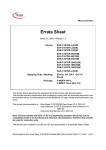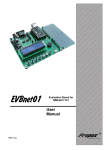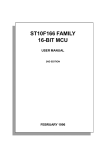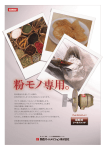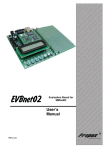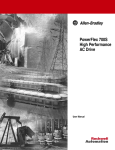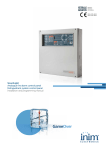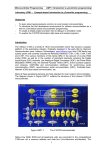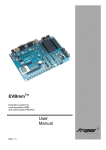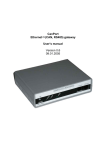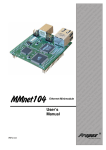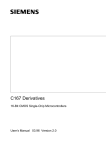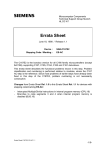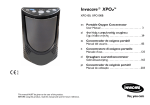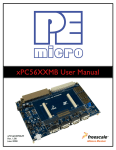Download TQM167U - TQ
Transcript
Minimodule TQM167U TQ-Minimodul TQM167U mit Microcontroller SAB-C167 Hardware - Manual © TQ components GmbH 2002 Minimodule TQM167U Hardware Manual for: TQM167U Rev100 Rev102 Rev103 Rev104 Rev105 Rev106 Rev107 Rev108 TQ-Components reserves the right to make changes without further notice to any products herein. TQ-Components makes no warranty, representation or guarantee regarding the suitability of its products for any particular purpose, nor does TQ-Components assume any liability arising out of the application or use of any product or circuit, and specifically disclaims any liability at all, including without limitation consequential or incidental damages. „Typical“ parameters which may be provided in TQ-Components data sheets and/or specifications can and do vary in different applications and actual performance may vary over time. All operating parameters, including „Typicals“ must be validated for each customer application by customer’s technical experts. TQ-Components does not convey any license under its patent rights nor the rights of others. TQ-Components products are not designed, intended, or authorised for use as components in systems intended for surgical implant into the body, or other applications intended to support or sustain life, or for any other application in which failure of the TQ-Components product could create a situation where personal injury or death may occur. Should a buyer purchase or use TQ-Components products for any such unintended or unauthorised application, a buyer shall indemnify and hold TQ-Components and its officers, employees, subsidiaries, affiliates, and distributors harmless against all claims, costs, damages, and expenses, and reasonable attorney fees arising out of, directly or indirectly, any claim of personal injury or death associated with such unintended or unauthorised use, even if such claim alleges that TQ-Components was negligent regarding the design or manufacture of the part. TQ-Components is registered trademark of TQ-Components GmbH. Reproduction, in part or whole, without the prior written consent of TQ-Components GmbH is prohibited. © TQ components GmbH 2002 2 Minimodule TQM167U Contents Pragraph Number Title 1 2 Page Number Introduction ...................................................................................................................................................4 Block-Diagram ..............................................................................................................................................5 2.1 Microcontroller SAB-C167CR-LM / SAB-C167CS-32FM .......................................................................5 2.2 Memory...................................................................................................................................................6 2.2.1 Flash-Memory..................................................................................................................................6 2.2.2 SRAM-Memory ................................................................................................................................6 2.2.3 Serials EEPROM .............................................................................................................................6 2.3 Reset-Logic.............................................................................................................................................6 2.4 Interface ..................................................................................................................................................6 2.4.1 Serial-Interface ................................................................................................................................6 2.4.2 CAN-Interface..................................................................................................................................6 2.4.3 Bus-Interface ...................................................................................................................................6 2.4.4 Internal Bootstrap Loader ................................................................................................................6 2.5 XREG......................................................................................................................................................6 2.6 7Segment Display...................................................................................................................................6 2.7 Internal LED ............................................................................................................................................7 3 Microcontroller ..............................................................................................................................................7 4 Memory.........................................................................................................................................................8 4.1 Flash-Memory.........................................................................................................................................8 4.1.1 Flash-Memory structure...................................................................................................................8 4.1.2 Flash EPROM BUSCON .................................................................................................................9 4.2 SRAM-Memory .......................................................................................................................................9 4.2.1 SRAM-Memory structure .................................................................................................................9 4.2.2 SRAM access times ......................................................................................................................10 4.3 SerialsEEPROM ...................................................................................................................................11 4.4 Memory Management...........................................................................................................................11 4.4.1 Principle of operation.....................................................................................................................11 4.4.2 Chip Select allocation ....................................................................................................................11 4.4.3 Programming of the Chip Select lines ...........................................................................................12 4.4.4 Programming the SYSCON registers............................................................................................13 4.4.5 Programming the XREG/External UART.......................................................................................14 4.4.6 Programming the flash EPROMs ..................................................................................................15 4.4.7 Examples of memory configurations .............................................................................................15 5 Interface......................................................................................................................................................16 5.1 Serial Interface......................................................................................................................................16 5.1.1 Internal asynchronous interface ....................................................................................................16 5.1.2 Internal synchronous interface ......................................................................................................16 5.1.3 External asynchronous interface ...................................................................................................17 5.2 CAN - Interface .....................................................................................................................................17 5.3 Bus - Interface ......................................................................................................................................17 5.4 Internal bootstrap loader.......................................................................................................................17 6 Power supply ..............................................................................................................................................18 6.1 Supply voltage ......................................................................................................................................18 6.2 Maximum supply current.......................................................................................................................18 7 Pin Configuration ........................................................................................................................................19 7.1 CPU Pins ..............................................................................................................................................19 7.2 Module Pins ..........................................................................................................................................22 8 Mechanical Data.........................................................................................................................................23 8.1 Connector .............................................................................................................................................23 8.2 Connector Position ...............................................................................................................................23 9 Pin Configuration ........................................................................................................................................24 9.1 Mechanikal Drawing .............................................................................................................................25 10 Order Code TQM167U: ..............................................................................................................................26 11 References .................................................................................................................................................28 © TQ components GmbH 2002 3 Minimodule TQM167U 1 Introduction TQ embedded Microcontroller Systems High integration and high reliability are what set the TQ-Components industrial microcontroller modules apart from the rest. TQ-Components Minimodules from credit-card to half credit-card size are unbeatable in various applications. With an ever-expanding product line and clear technology migration path, TQ-Components offers OEMs uncompromising excellence in microcontroller modules. In a variety of industrial measurement, process regulation and control developments engineers confronted with the task of developing a complex monitoring / control system under time constraints are the prime beneficiaries of our microcontroller devices. Compare the advantage of the implementing a TQComponents module to the total cost of a completely new circuitry design. Time to market TQ-Components microcontroller modules provide a drop-in CPU solution, with complete CPU kernel functionality on board. This enables engineers to take a project from concept to prototype or market in weeks, rather than in months or longer. Reliability TQ-Components modular embedded microcontroller Minimodules have proven to be reliable and rugged in numerous demanding and critical applications. Our highly knowledgeable team of electronic engineers has wide experience in designing embedded microcontroller Modules. The team‘s commitment to quality and reliability is evident throughout the whole TQ-Components product line. Upgradability Thanks to the flexibility of TQ’s product architectures, you will be able to enhance your products by taking advantage of a new technology as when it becomes available. Our products offer a migration path so you can upgrade features or performance without major redesign. TQ-Minimodules offers you ... þ Best price-performance relationship § § § uncompromising use of most modern production-technology low price through high production quantity Customised Versions on requests þ Maximum performance on small footprint § § § § double-sided SMT Technology Fine Pitch Multilayer Printed Circuit Boards using latest chip technology using latest Flash Memory technology þ save time and money in your development § § § § complete CPU kernel functionality on board immediate start through particular monitor-program works with most modern Software Development Tools such as compilers and debuggers Design-In Support through the manufacturer þ save time and money in your production and service § § § Download-Function for development, production and service simple Firmware-Updates through Download-Function Download over Standard RS232-Interface without additional switches and jumpers © TQ components GmbH 2002 4 Minimodule TQM167U 2 Block-Diagram EEPROM TQM16xU 4 KBiit Oscillator XREG SAB-C16x Micro-Controller 7-Segment Display Power-Fail- Logik 16-BitFlash-Memory 16-BitSRAM 256 KByte - 2 MByte 256 KByte - 2 MByte Reset-Generator, Watchdog, SRAM-Buffer Boot-Loader CAN-Interface Boot-Strap-LoaderControll-Logic with direct RS232-Connection 2* CAN Driver (TQM167C only) 40 MHz / 5 MHz MemoryManagement powerful and flexible Memory Management Port I/O 2. UART RS232-Interface all Port I/O, ControlData- and Addresslines 2. asynchronous serial Interface Line Driver for RS232-Interface 200 Pin Board-to-Board Connector , 0.8 mm Pitch Rev.100 2.1 Microcontroller SAB-C167CR-LM / SAB-C167CS-32FM § High Performance 16 Bit-CPU § 100 ns Instruction Cycle Time at 20 MHz CPU § Up to 16 MByte Linear Address Space for Code and Data § On-Chip CAN Interface (Version 2.0B) (1x SAB-C167CR-LM / 2x SAB-C167CS-32FM) § 16-channel 10-bit A/D Converter § Two 16-Channel Capture/Compare Units § 4-Channel PWM Unit § Two Multi-Functional General Purpose Timer Units with five 16-bit Timers § Programmable Watchdog Timer § Two Serial Channels (Synchronous/Asynchronous and High-Speed Synchronous) § On-Chip Bootstrap Loader Details see Siemens / Infineon User’s Manual SAB-C167 © TQ components GmbH 2002 5 Minimodule TQM167U 2.2 Memory 2.2.1 Flash-Memory § § § § § 256 kByte to 2 MByte organisation, 128k*16, 256k*16 or 512k*16, 1M*16, 90 or 70 ns access time on Board programmable Standard: 1 MByte 2.2.2 SRAM-Memory § § § § § 256 kByte to 2MByte organisation 2*128k*8, 2*512k*8, 2*1M*8, 55 ns access time external battery backup Standard: 256 kByte 2.2.3 Serials EEPROM § § § 2.3 § § 2.4 4 kBit organisation 512 * 8 Bit EEPROM is handled from XREG Reset-Logic CPU internal Watchdog Power-Fail Logic with MAX808 Interface 2.4.1 Serial-Interface § § § one internal asynchronous (integrated in the processor) • used unbuffered as RxD0 and TxD0 • with RS232 Driver as RxD0# and TxD0# one internal synchronous (integrated in the processor) one external asynchronous (ST16C550) 2.4.2 CAN-Interface § two internal CAN-Interfaces (integrated in the processor) 2.4.3 Bus-Interface § § Port I/O, Control- Data- and Addresslines No Bus Drivers 2.4.4 Internal Bootstrap Loader § § § 2.5 Download via serial Interface Powerful Download Tools Download to SRAM or Flash XREG External 16Bit Register to handle 7 Segment Display and EEPROM 2.6 § § 7Segment Display Free programmable Display (handled from XREG. Green display colour for standard module types. © TQ components GmbH 2002 6 Minimodule TQM167U 2.7 Internal LED The LED installed on the top of the module is connected to the reset output RSOUT# of the module. It lights when RSOUT# is active, i.e. until the EINIT command has been executed after a reset. 3 Microcontroller l l l l l l l l l l l l l l l l l l l l l l l High Performance 16-bit CPU with 4-Stage Pipeline 100 ns Instruction Cycle Time at 20 MHz CPU Clock Enhanced Boolean Bit Manipu-lation Facilities Additional Instructions to Support HLL and Operating Systems Register-Based Design with Multiple Variable Register Banks Single-Cycle Context Switching Support Clock Generation via on-chip PLL or via direct clock-input Up to 16 MBytes Linear Address Space for Code and Data 4/11 KBytes On-Chip SRAM (2/3 KB Internal RAM, 2/8 KBytes Extension RAM) (167CR/167CS) Programmable External Bus Characteristics for Different Address Ranges 8-bit or 16-bit External Data Bus Five Programmable Chip-Select Signals Hold- and Hold-Acknowledge Bus Arbitration Support 1024 Bytes On-Chip Special Function Register Area Idle and Power Down Modes 8-Channel Interrupt-Driven Single-Cycle Data Transfer Facilities via Peripheral Event Controller (PEC) 16-Priority-Level Interrupt System with 56 Sources, Sample-Rate down to 40 ns 16/24-Channel 10-bit A/D Converter with 9.7/7.8 µs Conversion Time (167CR/167CS) Two 16-Channel Capture/Compare Units 4-Channel PWM Unit Two Multi-Functional General Purpose Timer Units with five 16-bit Timers Two Serial Channels (Synchronous/Asynchronous and High-Speed-Synchronous) On-Chip CAN Interface 2.0 B active with 15 Message Objects (Full-CAN/Basic-CAN) (1* at SABC167CR / 2* at SAB-C167CS) © TQ components GmbH 2002 7 Minimodule TQM167U l l l Programmable Watchdog Timer Up to 111 General Purpose IO Lines, partly with Selectable Input Thresholds and Hysteresis On-Chip Bootstrap Loader Details see Siemens / Infineon User’s Manual SAB-C167CR / SAB-C167CS 4 Memory The flexible memory management of the TQM167U is different to most microcontroller modules of the same generation. The handling of the configuration of this module is more simple and flexible than in almost any other module. The installed processor is equipped with 5 freely programmable Chip Select outputs which access the respective system components. This allows a completely open memory configuration of the Minimodule. The memory management is described in detail in é Section4.4. 4.1 Flash-Memory 4.1.1 Flash-Memory structure Depending on the module variant, the non-volatile memory of the module is implemented with one 16-bit flash EPROM with variable storage capacity. This results in a possible memory space of 128K*16, 256k*16, 512K*16 or 1M*16 representing as memory capacity of 256 kByte, 512 kByte, 1 MByte or 2 Mbyte. The module TQM167U is therefore available with a maximum non-volatile memory of 2 MByte. For exact technical data of the applied memory chips, please refer to é Section 10. Details on programming are to be found in é Section 4.1.2 / 4.3.6 Depending on the equipping, the following memory configurations are possible: Flash1 Capacity: Address space: 256 kByte 256 kByte 128k x 16 512 kByte 512 kByte 256k x 16 1 MByte 1 MByte 512K x 16 2 Mbyte 2 Mbyte 1 M x 16 © TQ components GmbH 2002 8 Minimodule TQM167U 4.1.2 Flash EPROM BUSCON The BUSCON is dependent from the memory access time, type of Module (multiplexed or demultiplexed data bus mode) and latched or unlatched programmed Chip Selects. In strict compliance with the specifications, the following configurations are therefore possible: BUSCON 0 CS - Mode Bus type F Latched unlatched CSCFG = 0 CSCFG = 1 70ns demultiplexed 04BEh (1 WS) 150ns 04BEh (0 WS) 100ns 90ns demultiplexed 04BEh (1 WS) 150ns 04BEh (1 WS) 150ns 70ns multiplexed 04EEh (1 WS) 200ns 04EFh (0 WS) 150ns 90ns multiplexed 04EEh (1 WS) 200ns 04EEh (1 WS) 200ns Example: (70ns Flash EPROM, Multiplexed Bus, CSCFG =1) Field in BUSCON: Value: Delay: MCTC [BUSCON 0.0...3] 1111b 0 Waitstate RWDC [BUSCON 0.4] 0b MTTC [BUSCON 0.5] 1b No Delay The associated C command could then be as follows: è BUSCONx = 04EFh 4.2 SRAM-Memory 4.2.1 SRAM-Memory structure The static memory of the module is implemented by two 8-bit SRAMs with memory space of max 1M*16, representing a memory capacity of 2 MByte. The SRAM can be protected against data loss by a battery buffer. The associated connections are provided on the module. For exact technical data of the applied memory chips, please refer to é Section 10. Details on programming are to be found in é Section 4.2.2 / 4.3.7 Depending on the installed chips, the following memory configurations are possible: SRAM1 SRAM2 Capacity: Address space: 128 KByte 128 KByte 256 KByte 128K x 16 512 KByte 512 KByte 1MByte 512K x 16 1MByte 1MByte 2MByte 1M x 16 * Due to the 16-bit data and address buses, both memory chips are always installed * © TQ components GmbH 2002 9 Minimodule TQM167U 4.2.2 SRAM access times The static RAMs installed in the modules have a maximum access time of 55ns. The access speed can be programmed by the fields MCTC (Memory Cycle Time Control), MTTC (Memory Tri-State Time Control) and RWDC (Read/Write Delay Control) of the respective BUSCON register. The BUSCON is dependent from the memory access time, multiplexed or demultiplexed Data bus mode and latched or unlatched programmed Chip Selects. In strict compliance with the specifications, the following configuration is therefore possible: BUSCON 1 CS - Mode Bus type F Latched unlatched CSCFG = 0 CSCFG = 1 55ns demultiplexed 04BEh (1 WS) 150ns 04BFh (0 WS) 100ns 55ns multiplexed 04EEh (1 WS) 200ns 04EFh (0 WS) 150ns Example: (55ns SRAM memory, demultiplexed Bus, CSCFG =0) Field in BUSCON: Value: Delay: MCTC [BUSCON 0.0...3] 1110b 1 Waitstate RWDC [BUSCON 0.4] 1b MTTC [BUSCON 0.5] 1b No Delay The associated C command could then be as follows: è BUSCONx = 04BEh © TQ components GmbH 2002 10 Minimodule TQM167U 4.3 SerialsEEPROM The EEPROM is switchable and work in a 8bit or 16bit modus. Details on programming are to be found in é Section 4.4.5.2 4.4 Memory Management This section contains all details and the know-how necessary for optimum usage of the memory installed in the module. The memory range management and configuration (memory management) can be implemented entirely by software. The address ranges can be programmed flexibly with the 5 freely programmable CS outputs of the processor and the associated configuration registers. 4.4.1 Principle of operation The microcontroller SAB-C167CR/CS is equipped with 5 freely programmable Chip Select outputs which allow access to the respective periphery. For each address block allocated to a Chip Select output, it is also possible to select an individual configuration of the system bus. For this, the bus type, bus width, wait states and also the memory block can be allocated to a CS signal. CS0 addresses all memory blocks of the addressable range not allocated to CS1-CS4. This makes it possible to manage non-sequential memory blocks without further measures. After a reset, the Chip Select lines CS1-CS4 of the processor are inactive. In this case, CS0 is active for the entire memory range. To allow programs in the flash EPROM to be started, CS0 is used to address these memory chips after a reset. 4.4.2 Chip Select allocation The memory configuration applicable in most cases is works-adjusted by the manufacturer: • CS0 addresses the flash EPROMs, • CS1 the SRAMs. For programming, please refer to é Section 4.4.4 of this description. Standard settings by TQ-Components: Control line Connected chip CS0# On-board flash EPROM CS1# On-board SRAM CS2# external. UART / XREG CS3# external CS-Signal CS4# external CS-Signal CS0# Reset configuration © TQ components GmbH 2002 000000h- FFFFFFh 11 Flash EPROM Minimodule TQM167U 4.4.3 Programming of the Chip Select lines The Chip Select lines are programmed by software via the registers BUSCON0..4 and ADDRSEL1..4. The BUSCON registers define the hardware configuration of the system bus, the ADDRSEL registers the scope and size of memory. In this, it must be observed that ADDRSEL0 does not exist because, as described in Sect. xx, all memory space outside the defined ranges of CS1-CS4 is allocated to the Chip Select line CS0. BUSCON registers The BUSCON registers are all adjustable by software. These are not preset apart from the BUSCON0 register. The following parameter can be set individually through the BUSCON registers for each memory block initialised with the respective CS lines: • Bus width: The system bus can be selected with a width of 8 or 16 bits. If an 8-bit bus is selected, first the Low byte and then the High byte are transferred through the data lines D0-D7. • Bus type: This allows the selection of a multiplexed or non-multiplexed bus. • Wait states: Up to 15 wait states, memory tristates and a R/W delay can be specified. • Miscellaneous: The length of the ALE signal and the functions of RD# and WR# can also be influenced here. The exact programming is to be found in the Microprocessor manual. ADDRSEL registers The division of the memory range is performed with the ADDRSEL registers. For this, the starting address of the memory block and the memory size must be specified: ADDRSELx: 15 14 13 12 11 10 9 8 7 Range Start Address 6 5 4 3 2 1 0 Range Size Selection • Range Start Address (RGSAD) specifies the starting address of the memory block for the respective CS line (only integer multiples of the adjusted block size (RGSZ) are valid as the starting address; see table). © TQ components GmbH 2002 12 Minimodule TQM167U • Range Size Selection (RGSZ) Specifies the memory size as shown in the table below. The following table is intended to simplify programming. RGSZ: Memorysize 0000 0001 0010 0011 0100 0101 0110 0111 1000 1001 1010 1011 Rest: 4 Kbyte 8 Kbyte 16 Kbyte 32 Kbyte 64 Kbyte 128 Kbyte 256 Kbyte 512 Kbyte 1 MByte 2 MByte 4 MByte 8 MByte Not defined RGSAD: RRRRRRRRRRRRb RRRRRRRRRRRxb RRRRRRRRRRxxb RRRRRRRRRxxxb RRRRRRRRxxxxb RRRRRRRxxxxxb RRRRRRxxxxxxb RRRRRxxxxxxxb RRRRxxxxxxxxb RRRxxxxxxxxxb RRxxxxxxxxxxb Rxxxxxxxxxxxb Startaddress RRRRRRRRRRRRb * 4KByte RRRRRRRRRRR0b * 4KByte RRRRRRRRRR00b * 4KByte RRRRRRRRR000b * 4KByte RRRRRRRR0000b * 4KByte RRRRRRR00000b * 4KByte RRRRRR000000b * 4KByte RRRRR0000000b * 4KByte RRRR00000000b * 4KByte RRR000000000b * 4KByte RR0000000000b * 4KByte R00000000000b * 4KByte R: used bit; x: unused bit F Example: ADDRSEL4 = 1A42h; (= 0001 1010 0100 0010b) Specifies a 16 KByte block of memory from address 1A4000h for access to external memory. 4.4.4 Programming the SYSCON registers The TQM167U takes the Byte access to the 16 Bit Bus with the Signals WRL# and WRH#. WRL# will be active, when you write to the lowest Byte (LBS). Therefore Bit WRCFG in the SYSCON will be setted. è è WRCFG = 1 The SAB-C167 can use the Chip Select Signals on two different Modes. 4.4.4.1 Latched CS# Modus After the ALE Signal lost his value the CS# - Signals change his level. Therefore this Modus shows a clear but a slow Bustiming. 4.4.4.2 Unlatched CS# Modus The CS# -Signals changing together with the Addresslines his level. The Bustiming is fast. Therefore it could be that we have on the CS# lines some Spikes between the bus access times. The Spikes takes no effect on theTQM167U. Please be careful with your on Peripheries. Details see Siemens / Infineon User’s Manual SAB-C167CR / SAB-C167CS © TQ components GmbH 2002 13 Minimodule TQM167U 4.4.5 Programming the XREG/External UART BUSCON2 will be configured as a 8-Bit –Bus with RW/Delay and an minimum of 2 Waitstates. è BUSCON2 = 060Dh 4.4.5.1 Address Area from the XREG The XREG is addressed when A10 = 1, A11 = 0 and CS#2 = 0. Because of that it results a relative Address area from 0400h – 07FFh. Only the Addresses 400h and 401h are used. 4.4.5.2 Configuration from the XREG Relative Address 400h Bit Meaning Read/Write Function 7 DP W 6 G W Relative Address 401h Bit 7 6 Meaning DNU DNU Read/Write W W Function Free for Ex W: only Write R/W: Read and Write DNU: Do not use / set to 0 5 F W 4 3 E D W W 7 – Segment - Display 5 4 XR13 XR12 W W Port Pins 3 ORG W 2 C W 1 B W 2 1 STRB CLR W W EEPROM 93C66 0 A W 0 Data R/W 4.4.5.3 Address Area UART The UART is addressed when A11 = 1 and .CS#2 = 0 Because of that it results a relative Address area from 0800h – 0FFFh. Only the Address area from 800h - 807h is used. 4.4.5.4 Free Address Area from CS 2# A free relative Address Area on CS2# from 0000h – 03FFh can be used for external Applications. © TQ components GmbH 2002 14 Minimodule TQM167U 4.4.6 Programming the flash EPROMs Bit A0 of the flash EPROM is connected to A1 of the address bus. Therefor the Flash EPROM an be programmed only wordwise. During programming the addresses which are used has to be doubled. If the Flash EPROM should be programmed bytewise following procedure should be used: 1. Read out the data word which has the byte that should be changed 2. Change the byte 3. Write back the data word. F Example: Word Program st nd rd th 1 Buscycle 2 Buscycle 3 Buscycle 4 Buscycle Addrerss Data Address Data Address Data Address Data Standard 5555h 00AAh 2AAAh 0055h 5555h 00A0h PA Data TQM167 AAAAh 00AAh 5554h 0055h AAAAH 00A0h PA Data PA: the address to be programmed is equal in both cases. 4.4.7 Examples of memory configurations The Examples are configured with 70ns FLASH and demultiplexed BUS 4.4.7.1 Memory allocation used by the monitor Program MON16U and C166Mon (Keil) Memory-Area Chip CS# BUSCON-Register ADDRSEL-Register 000000h-1FFFFFh SRAM 1 04BFh 0009h 200000h-3FFFFFh Flash-EPROM 0 04BFh -------- 400000h-400FFFh External Uart / XREG 2 060Dh 4000h 500000h-5FFFFFh External Memory 3 048Eh 5008h 4.4.7.2 Memory allocation after download to the RAM Memory-Area Chip CS# BUSCON-Register ADDRSEL-Register 000000h-1FFFFFh SRAM 1 04BFh 0009h 200000h-3FFFFFh Flash-EPROM 0 04BFh -------- These are two concrete proposals of memory configurations which ensure stable operation: Variant for a program in flash memory Variant for a program in SRAM © TQ components GmbH 2002 15 Minimodule TQM167U 5 5.1 Interface Serial Interface The module is equipped with three serial interfaces: • one internal asynchronous (integrated in the processor) • one internal synchronous (integrated in the processor) • one external asynchronous (ST16C550) 5.1.1 Internal asynchronous interface Initialisation: The internal asynchronous interface operates directly with the processor clock. For programming, please refer to the initialisation recommended in the manual. Hardware configuration: The interface is equipped with two connections on the module: • Unbuffered as RxD0 and TxD0. • With RS232 driver as RxD0# and TxD0#. 5.1.2 Internal synchronous interface Initialisation: See é Section 5.1.1 Hardware configuration: The conductors of the synchronous interface are connected to port 3 and can be used without limitations. This Interface can be used up to 5 Mbaud. P3.8 MRST P3.9 MTSR P3.13 SCLK © TQ components GmbH 2002 16 Minimodule TQM167U 5.1.3 External asynchronous interface Initialisation: The external asynchronous interface operates directly with the 16C550. The UART interface is accessed at Chip Select 2 (CS2#) The frequency of XTAL1/2 is 14,7456 MHz INT is connected over 1 K to pin P7.6 from the C167. Hardware configuration: The interface is equipped with two connections on the module: • Unbuffered as RxD1 and TxD1. • With RS232 driver as RxD1# and TxD1#. 5.2 CAN - Interface • Unbuffered as CAN1-RxD and CAN1-TxD and CAN2-RxD and CAN2-TxD. • With CAN driver (2 X PCA82C251) as CAN1_H and CAN1_L and CAN2_H and CAN2. 5.3 Bus - Interface All Port I/O, Control- Data- and Addresslines are available and connected to X1 and X2. For Pin Configuratin, please refer to é Section 6 of this description. 5.4 Internal bootstrap loader The installed processor is equipped with a bootstrap loader which, in conjunction with the periphery implemented in the module, makes programming of the EPROMs unnecessary. The downloading of a program to the module can be performed via the serial interface In this way, programs can be downloaded from a PC without additional hardware, either to the SRAM or to the flash EPROM. Because the internal bootstrap loader of the processor can only process 32 bytes, it is necessary to transfer programs in several blocks into the memory of the module. Functional sequence: 1. To activate the bootstrap loader, a reset must first be initiated (RTS and DTR active = 1). 2. The reset is enabled after approx. 10 ms, the DTR line remains active. 3. The processor then enters the bootstrap loader mode and waits for a Null byte transmitted via ASC0. 4. The processor then returns an acknowledgement byte ($A5), which can be used to identify the processor. 5. 32 bytes are then transmitted by the PC, which are loaded directly into the internal RAM of the processor. © TQ components GmbH 2002 17 Minimodule TQM167U To allow convenient downloading of programs with larger memory requirement, TQ has developed the program BOOT16x (DOS Version) and TQLoad (Windows Version). The program BOOT16x provides user-friendly control of the entire loading operation. More detailed explanations and examples of this are to be found in the Software Manual. The following signal lines of the serial interface are used (by the PC) for the download: TQM167 Signal Pin Pin PC (DSUB-9) Signal PC (DSUB-25) Pin Signal RESINS# X1-52 ↔ 7 RTS 4 RTS TXD0# X1-55 ↔ 2 RxD 3 RxD GND X1-2 ↔ 5 GND 7 GND GND X1-40 ↔ 5 GND 7 GND BOOTSTR# X1-53 ↔ 4 DTR 20 DTR RXD0# X1-56 ↔ 3 TxD 2 TxD 6 Power supply 6.1 Supply voltage The supply voltage for the TQM167U is defined as follows: Vcc = 5V ± 4,5% = 4,775V ..5,225V The tolerances of supply voltage depend on the used supervisor circuit MAX808L. 6.2 Maximum supply current The maximum supply current for the TQM167U is defined as follows: With 7 segment display: Imax = 250mA Without 7 segment display: Imax = 200mA © TQ components GmbH 2002 18 Minimodule TQM167U 7 Pin Configuration This chapter describes the function of the TQM167U connections. 7.1 CPU Pins Signal P0L.0 / AD0 P0L.1 / AD1 P0L.2 / AD2 P0L.3 / AD3 P0L.4 / AD4 P0L.5 / AD5 P0L.6 / AD6 P0L.7 / AD7 P0H.0 / AD8 P0H.1 / AD9 P0H.2 / AD10 P0H.3 / AD11 P0H.4 / AD12 P0H.5 / AD13 P0H.6 / AD14 P0H.7 / AD15 P1L.0 / A0 / AN16 P1L.1 / A1 / AN17 P1L.2 / A2 / AN18 P1L.3 / A3 / AN19 P1L.4 / A4 / AN20 P1L.5 / A5 / AN21 P1L.6 / A6 / AN22 P1L.7 / A7 / AN23 P1H.0 / A8 P1H.1 / A9 P1H.2 / A10 P1H.3 / A11 P1H.4 / A12 / CC24IO P1H.5 / A13 / CC25IO P1H.6 / A14 / CC26IO P1H.7 / A15 / CC27IO P2.0 / CC0IO P2.1 / CC1IO P2.2 / CC2IO P2.3 / CC3IO P2.4 / CC4IO P2.5 / CC5IO P2.6 / CC6IO P2.7 / CC7IO P2.8 / CC8IO / EX0IN P2.9 / CC9IO / EX1IN P2.10 / CC10IO / EX2IN P2.11 / CC11IO / EX3IN P2.12 / CC12IO / EX4IN P2.13 / CC13IO / EX5IN CPU-Pin Module-Pin 100 X1-32 101 X1-31 102 X1-30 103 X1-29 104 X1-28 105 X1-27 106 X1-26 107 X1-25 108 X1-24 111 X1-23 112 X1-22 113 X1-21 114 X1-20 115 X1-19 116 X1-18 117 X1-17 118 X2-19 119 X2-20 120 X2-21 121 X2-22 122 X2-23 123 X2-24 124 X2-25 125 X2-26 128 X2-27 129 X2-28 130 X2-29 131 X2-30 132 X2-31 133 X2-32 134 X2-33 135 X2-34 47 X2-72 48 X2-73 49 X2-74 50 X2-75 51 X2-76 52 X2-77 53 X2-78 54 X2-79 57 X2-80 58 X2-81 59 X2-82 60 X2-83 61 X2-84 62 X2-85 © TQ components GmbH 2002 19 Type I/O I/O I/O I/O I/O I/O I/O I/O I/O I/O I/O I/O I/O I/O I/O I/O I/O I/O I/O I/O I/O I/O I/O I/O I/O I/O I/O I/O I/O I/O I/O I/O I/O I/O I/O I/O I/O I/O I/O I/O I/O I/O I/O I/O I/O I/O Description P0L.0 – direct connected buffered P0L.1 – direct connected buffered P0L.2 – direct connected buffered P0L.3 – direct connected buffered P0L.4 – direct connected buffered P0L.5 – direct connected buffered P0L.6 – direct connected buffered P0L.7 – direct connected buffered P0H.0 – direct connected buffered P0H.1 – direct connected buffered P0H.2 – direct connected buffered P0H.3 – direct connected buffered P0H.4 – direct connected buffered P0H.5 – direct connected buffered P0H.6 – direct connected buffered P0H.7 – direct connected buffered P1L.0 - direct connected buffered P1L.1 - direct connected buffered P1L.2 - direct connected buffered P1L.3 - direct connected buffered P1L.4 - direct connected buffered P1L.5 - direct connected buffered P1L.6 - direct connected buffered P1L.7 - direct connected buffered P1H.0 - direct connected buffered P1H.1 - direct connected buffered P1H.2 - direct connected buffered P1H.3 - direct connected buffered P1H.4 - direct connected buffered P1H.5 - direct connected buffered P1H.6 - direct connected buffered P1H.7 - direct connected buffered Port P2.0 – direct connected Port P2.1 – direct connected Port P2.2 – direct connected Port P2.3 – direct connected Port P2.4 – direct connected Port P2.5 – direct connected Port P2.6 – direct connected Port P2.7 – direct connected Port P2.8 – direct connected Port P2.9 – direct connected Port P2.10 – direct connected Port P2.11 – direct connected Port P2.12 – direct connected Port P2.13 – direct connected Minimodule TQM167U Signal P2.14 / CC14IO / EX6IN P2.15 / CC15IO / EX7IN / T7IN P3.0 / T0IN P3.1 / T6OUT P3.2 / CAPIN P3.3 / T3OUT P3.4 / T3EUD P3.5 / T4IN P3.6 / T3IN P3.7 / T2IN P3.8 / MRST P3.9 / MTSR P3.10 / TxD0 CPU-Pin Module-Pin 63 X2-86 64 X2-87 65 X1-78 66 X1-77 67 X1-76 68 X1-75 69 X1-74 70 X1-73 73 X1-72 74 X1-71 75 X1-70 76 X1-69 77 X1-68 Type I/O I/O I/O I/O I/O I/O I/O I/O I/O I/O I/O I/O O P3.11 / RxD0 78 X1-67 I P3.12/WRHB# P3.13 / SCLK P3.15 / CLKOUT / FOUT P4.0 / A16 79 80 81 85 X1-66 X1-65 X1-63 X1-47 O O O O P4.1 / A17 86 X1-46 O P4.2 / A18 87 X1-45 O P4.3 / A19 88 X1-44 O P4.4 / A20 / CAN2_RxD 167CS 89 X1-43 O P4.5 / A21 / CAN1_RxD 167CR 90 X1-42 O P4.6 / A22 / CAN1_TxD 167CR 91 X1-41 O P4.7 / A23 / CAN2_TxD 167CS 92 X1-38 O 27 28 29 30 31 32 33 34 35 36 39 40 41 X2-101 X2-102 X2-103 X2-104 X2-105 X2-106 X2-107 X2-108 X2-109 X2-110 X2-111 X2-112 X2-113 I I I I I I I I I I I I I P5.0 / AN0 P5.1 / AN1 P5.2 / AN2 P5.3 / AN3 P5.4 / AN4 P5.5 / AN5 P5.6 / AN6 P5.7 / AN7 P5.8 / AN8 P5.9 / AN9 P5.10 / AN10 / T6EUD P5.11 / AN11 / T5EUD P5.12 / AN12 / T6IN © TQ components GmbH 2002 20 Description Port P2.14 – direct connected Port P2.15 – direct connected Port P3.0 – direct connected Port P3.1 – direct connected Port P3.2 – direct connected Port P3.3 – direct connected Port P3.4 – direct connected Port P3.5 – direct connected Port P3.6 – direct connected Port P3.7 – direct connected Port P3.8 – direct connected Port P3.9 – direct connected Port P3.10 – direct connected Connected to RS232 driver Port P3.11 – direct connected Connected to RS232 driver WRH# active buffered Port P3.13 – direct connected Port P3.15 – direct connected Port P4.0 – direct connected Used as Address Line for 2 MB SRAM/Flash Port P4.1 – direct connected Used as Address Line for 2 MB SRAM/Flash Port P4.2 – direct connected Used as Address Line for 2 MB SRAM/Flash Port P4.3 – direct connected Used as Address Line for 2 MB SRAM/Flash Port P4.4 – direct connected Used as Address Line for 2 MB SRAM/Flash Option 16 Connected to CAN2 Driver Port P4.5 – direct connected Option 8 Connected to CAN1 Driver Port P4.6 – direct connected Option 8 Connected to CAN1 Driver Port P4.7 – direct connected Option 16 Connected to CAN2 Driver Port P5.0 – direct connected Port P5.1 – direct connected Port P5.2 – direct connected Port P5.3 – direct connected Port P5.4 – direct connected Port P5.5 – direct connected Port P5.6 – direct connected Port P5.7 – direct connected Port P5.8 – direct connected Port P5.9 – direct connected Port P5.10 – direct connected Port P5.11 – direct connected Port P5.12 – direct connected Minimodule TQM167U Signal P5.13 / AN13 / T5IN P5.14 / AN14 / T4EUD P5.15 / AN15 / T2EUD P6.0 / CS1# P6.1 / CS1# P6.2 / CS2# CPU-Pin Module-Pin 42 X2-114 43 X2-115 44 X2-116 1 2 3 X2-38 Type I I I I/O I/O I/O P6.3 / CS3# P6.4 / CS4# P6.5 / HOLD# P6.6 / HLDA# P6.7 / BREQ# P7.0 / POUT0 P7.1 / POUT1 P7.2 / POUT2 P7.3 / POUT3 P7.4 / CC28IO P7.5 / CC29IO P7.6 / CC30IO / INT 4 5 6 7 8 19 20 21 22 23 24 25 X2-39 X2-40 X2-41 X2-42 X2-43 X2-52 X2-53 X2-54 X2-55 X2-56 X2-57 X2-58 I/O I/O I/O I/O I/O I/O I/O I/O I/O I/O I/O I/O P7.7 / CC31IO P8.0 / CC16IO P8.1 / CC17IO P8.2 / CC18IO P8.3 / CC19IO P8.4 / CC20IO P8.5 / CC21IO P8.6 / CC22IO P8.7 / CC23IO NMI# 26 9 10 11 12 13 14 15 16 142 X2-61 X2-44 X2-45 X2-46 X2-47 X2-48 X2-49 X2-50 X2-51 X2-37 I/O I/O I/O I/O I/O I/O I/O I/O I/O I RSTOUT# 141 X2-36 O RSTIN# ALE EA# 140 98 99 X2-35 X1-34 X1-33 I/O O I READY# 97 X1-35 I RD# WRLB# VPP VAGND VAREF 95 96 84 X1-37 X1-36 X1-50 X2-118 X2-117 O O - 167CR – only for SAB-C167CR – only for SAB-C167CS Option 8 – only for CAN Driver 1 / Option 8 Option 16 – only for CAN Driver 2 / Option 16 CS2# - can be not used when Option 2, 4 or 32 # = active low or inverted signal 167CS © TQ components GmbH 2002 21 Description Port P5.13 – direct connected Port P5.14 – direct connected Port P5.15 – direct connected Port P6.0 – not connected only internal Port P6.1 – not connected only internal CS2# Port P6.2 – direct connected Used as Chip Select line for EEPROM, UART and 7 Segment Display Port P6.3 – direct connected Port P6.4 – direct connected Port P6.5 – direct connected Port P6.6 – direct connected Port P6.7 – direct connected Port P7.0 – direct connected Port P7.1 – direct connected Port P7.2 – direct connected Port P7.3 – direct connected Port P7.4 – direct connected Port P7.5 – direct connected Port P7.6 – direct connected, Interupt line external UART connected via 1kOhm. Port P7.7 – direct connected Port P8.0 – direct connected Port P8.1 – direct connected Port P8.2 – direct connected Port P8.3 – direct connected Port P8.4 – direct connected Port P8.5 – direct connected Port P8.6 – direct connected Port P8.7 – direct connected NMI# - direct connected / int. Connected through 4,7Kohm to VCC RSTOUT# - direct connected / internal Connected to an Inv. (RESET) RST -LED RSTIN# - direct connected ALE - direct connected EA# - direct connected / int. Connected through 4,7Kohm to GND READY# - direct connected / int. Connected through 4,7Kohm to VCC RD# - active buffered WRLB# - active buffered NC Reference voltage for the A/D converter Reference ground for the A/D converter Minimodule TQM167U 7.2 Module Pins Signal TxD0# Module-Pin X1-55 Type O RxD0# X1-56 I TxD1# X1-57 O RxD1# X1-58 I TxD1 RxD1 DTR# RTS# OUT1# OUT2# RI# CD# DSR# CTS# XR12 XR13 BAUDOUT# CAN1_H CAN1_L CAN2_H CAN2_L RSINS# BOOTSTR# X1-14 X1-13 X1-3 X1-4 X1-5 X1-6 X1-7 X1-8 X1-9 X1-10 X1-16 X1-15 X1-11 X1-60 X1-62 X1-59 X1-61 X1-52 X1-53 O I O O O O I I I I O O O LOWL# VBAT VCC – 5V VCC – 5V VCC – 5V VCC – 5V VCC – 5V VCC – 5V DGND DGND DGND DGND DGND DGND X1-54 X1-51 X1-1 X1-39 X1-79 X2-1 X2-59 X2-119 X1-2 X1-40 X1-80 X2-2 X2-60 X2-120 - Description RS232 output of the internal serial interface ASCO Level adjustment by MAX3232 RS232 input of the internal serial interface ASCO Level adjustment by MAX3232 RS232 output of the external serial interface Level adjustment by MAX3232 RS232 input of the external serial interface Level adjustment by MAX3232 RS232 output of the external serial interface not buffered RS232 input of the external serial interface not buffered Data Terminal Ready ST16C550 external UART Request to Send ST16C550 external UART Output 1 (User defined) ST16C550 external UART Output 2 (User defined) ST16C550 external UART Ring Indicator ST16C550 external UART Carrier Detect ST16C550 external UART Data Set Ready ST16C550 external UART Clear to Send ST16C550 external UART Free programmable XREG output Free programmable XREG output Baud Rate Generator output ST16C550 external UART HIGH level CAN1 voltage input/output LOW level CAN1 voltage input/output HIGH level CAN2 voltage input/output LOW level CAN2 voltage input/output Reset in (Bootstrap Loader) Bootstrap loader input to activate the bootstrap loader mode via the serial interface. Positive voltage bootstrap mode active. Low-Line Comparator output Backup Battery input Digital voltage Digital voltage Digital voltage Digital voltage Digital voltage Digital voltage Digital ground Digital ground Digital ground Digital ground Digital ground Digital ground # = active low or inverted signal © TQ components GmbH 2002 22 Minimodule TQM167U 8 8.1 Mechanical Data Connector Board-to-Board Option Distance No. of Pin Qty 5 mm Modul Supplier Order No. No. Of Pin 120 80 120 6 mm 1 AMP Berg 177983-5 61082-121000 120 80 5 7 mm 120 80 1 AMP Berg 177983-3 61082-081000 8 mm 80 120 80 8.2 Connector Position Top View: TQM167U © TQ components GmbH 2002 Bottom View: TQM167U 23 Base Board Connector Supplier Order No. AMP 177984-5 Berg 61083-121000 AMP 177984-3 Berg 61083-081000 AMP 5-179029-5 Berg 61083-122000 AMP 5-179029-3 Berg 61083-082000 AMP 5-179030-5 Berg 61083-123000 AMP 5-179030-3 Berg 61083-083000 AMP 5-179031-5 Berg 61083-124000 AMP 5-179031-3 Berg 61083-084000 Minimodule TQM167U 9 Pin Configuration Pin NoX2 Function Pin NoX2 2 DGND 1 4 NC – Spare 3 6 NC – Spare 5 8 NC – Spare 7 10 NC – Spare 9 12 NC – Spare 11 14 NC – Spare 13 16 NC - Spare 15 18 NC - Spare 17 20 P1L.1 / A1 / AN17 19 22 P1L.3 / A3 / AN19 21 24 P1L.5 / A5 / AN21 23 26 P1L.7 / A7 / AN23 25 28 P1H.1 / A9 27 30 P1H.3 / A11 29 32 P1H.5 / A13 / CC25IO 31 34 P1H.7 / A15 / CC27IO 33 36 RSTOUT# 35 38 P6.2 / CS2# 37 40 P6.4 / CS4# 39 42 P6.6 / HLDA# 41 44 P8.0 / CC16IO 43 46 P8.2 / CC18IO 45 48 P8.4 / CC20IO 47 50 P8.6 / CC22IO 49 52 P7.0 / POUT0 51 54 P7.2 / POUT2 53 56 P7.4 / CC28IO 55 58 P7.6 / CC30IO 57 60 DGND 59 62 NC – P9.0 61 64 NC - P9.2 63 66 NC - P9.4 65 68 NC - P9.6 67 70 NC – USB 69 72 P2.0 / CC0IO 71 74 P2.2 / CC2IO 73 76 P2.4 / CC4IO 75 78 P2.6 / CC6IO 77 Function VCC5V NC – Spare NC – Spare NC – Spare NC – Spare NC – Spare NC – Spare NC – Spare NC – Spare P1L.0 / A0 / AN16 P1L.2 / A2 / AN18 P1L.4 / A4 / AN20 P1L.6 / A6 / AN22 P1H.0 / A8 P1H.2 / A10 P1H.4 / A12 / CC24IO P1H.6 / A14 / CC26IO RSTIN# NMI# P6.3 / CS3# P6.5 / HOLD# P6.7 / BREQ# P8.1 / CC17IO P8.3 / CC19IO P8.5 / CC21IO P8.7 / CC23IO P7.1 / POUT1 P7.3 / POUT3 P7.5 / CC29IO VCC5V P7.7 / CC31IO NC - P9.1 NC - P9.3 NC - P9.5 NC - P9.7 NC - USB P2.1 / CC1IO P2.3 / CC3IO P2.5 / CC5IO Pin No X1 2 4 6 8 10 12 14 16 18 20 22 24 26 28 30 32 34 36 38 Function Pin No X1 1 3 5 7 9 11 13 15 17 19 21 23 25 27 29 31 33 35 37 Function 79 81 P2.7 / CC7IO P2.9 / CC9IO / EX1IN 40 42 83 44 46 P4.1/A17 45 48 NC – reserved 47 P4.0/A16 90 92 94 96 98 100 102 104 NC - IOM2 NC - IOM2 NC – JTAG NC – JTAG NC – JTAG NC – JTAG P5.1 / AN1 P5.3 / AN3 89 91 93 95 97 99 101 103 P2.11 / CC11IO / EX3IN P2.13 / CC13IO / EX5IN P2.15 / CC15IO / EX7IN / T7IN NC - IOM2 NC - IOM2 NC - JTAG NC - JTAG NC - JTAG NC - JTAG P5.0 / AN0 P5.2 / AN2 VCC5V P4.6 / A22 / CAN1_TxD167CR P4.4 / A20 / CAN2_RxD167CS P4.2/A18 88 P2.8 / CC8IO / EX0IN P2.10 / CC10IO / EX2IN P2.12 / CC12IO / EX4IN P2.14 / CC14IO / EX6IN NC - IOM2 DGND RTS# OUT2# CD# CTS# NC - Uart_opt TxD1 XR12 P0H.6 / AD14 P0H.4 / AD12 P0H.2 / AD10 P0H.0 / AD8 P0L.6 / AD6 P0L.4 / AD4 P0L.2 / AD2 P0L.0 / AD0 ALE WRLB# P4.7 / A23 / CAN2_TxD167CS DGND P4.5 / A21 / CAN1_RxD167CR P4.3 / A19 50 52 54 56 58 60 62 64 VPP RSINS# LOWL# RxD0# RxD1# CAN1_H CAN1_L NC - P3.14 49 51 53 55 57 59 61 63 P5.4 / AN4 P5.6 / AN6 P5.8 / AN8 P5.10 / AN10 / T6EUD P5.12 / AN12 / T6IN P5.14 / AN14 / T4EUD VAREF VCC5V 66 68 70 72 74 76 78 80 P3.12/WRHB# P3.10 / TxD0 P3.8 / MRST P3.6 / T3IN P3.4 / T3EUD P3.2 / CAPIN P3.0 / T0IN DGND 65 67 69 71 73 75 77 79 NC – Reserved VBAT BOOTSTR# TxD0# TxD1# CAN2_H CAN2_L P3.15 / CLKOUT / FOUT P3.13 / SCLK P3.11 / RxD0 P3.9 / MTSR P3.7 / T2IN P3.5 / T4IN P3.3 / T3OUT P3.1 / T6OUT VCC5V 80 82 84 86 85 87 106 P5.5 / AN5 105 108 P5.7 / AN7 107 110 P5.9 / AN9 109 112 P5.11 / AN11 / T5EUD 111 114 P5.13 / AN13 / T5IN 113 116 P5.15 / AN15 / T2EUD 115 118 AGND 117 120 DGND 119 NC – xxx is not connected / for future use © TQ components GmbH 2002 24 39 41 43 VCC5V DTR# OUT1# RI# DSR# BAUDOUT# RxD1 XR13 P0H.7 / AD15 P0H.5 / AD13 P0H.3 / AD11 P0H.1 / AD9 P0L.7 / AD7 P0L.5 / AD5 P0L.3 / AD3 P0L.1 / AD1 EA# READY# RD# Minimodule TQM167U 9.1 Mechanikal Drawing © TQ components GmbH 2002 25 Minimodule TQM167U 10 Order Code TQM167U: Module TQM167UK7RCS032 Order Code TQM167U-AB Description Module TQM167U with • SAB-C167CS Processor • 20 MHz Processor Speed • 1MByte Flash Bottom Boot, 70ns • 1 MByte SRAM, 50ns • with RS232 Driver • with external UART • with CAN driver 1 and CAN driver 2 • with 7 segment display • temperature range 0°C..70°C TQM167UK7KCR16 TQM167U-AC Module TQM167U with • SAB-C167CR Processor • 20 MHz Processor Speed • 1MByte Flash Bottom Boot, 70ns • 1 MByte SRAM, 70ns • with RS232 Driver • with external UART • with CAN driver 1 • temperature range 0°C..70°C TQM167UK7KCR24 TQM167U-AF Module TQM167U with • SAB-C167CR Processor • 20 MHz Processor Speed • 1MByte Flash Bottom Boot, 70ns • 1 MByte SRAM, 70ns • with RS232 Driver • with external UART • temperature range 0°C..70°C © TQ components GmbH 2002 26 Minimodule TQM167U TQM v1 U w1 w2 x v2 s z t t: Temperature Range blank = 0°C...+70°C I = -40°C...+85°C sz: Options Basic Options blank 001 002 004 008 016 032 = = = = = = = s: CPU Clock Speed blank = A = Standard (RS232, UART, EEPROM, CAN Driver) without RS232 Driver without external UART without EEPROM without CAN Driver 1 without CAN Driver 2 with 7 Segment Display 20 MHz 24 MHz v2: Microcontroller Version CR = Infineon C167CR CS = Infineon C167CS x: SRAM Memory A = C = D = H K = L = P = R = S = 256 kByte (2* 128 kBit * 8 / 1 Mbit), 70 ns 1 MByte (2* 512 kBit * 8 / 4 Mbit), 70 ns 2 MByte (2* 1 MBit * 8 / 8 Mbit), 70 ns 256 kByte (2* 128 kBit * 8 / 1 Mbit), 55 ns 1 MByte (2* 512 kBit * 8 / 4 Mbit), 55 ns 2 MByte (2* 1 MBit * 8 / 8 Mbit), 55 ns 256 kByte (2* 128 kBit * 8 / 1 Mbit), 50 ns 1 MByte (2* 512 kBit * 8 / 4 Mbit), 50 ns 2 MByte (2* 1 MBit * 8 / 8 Mbit), 50 ns w: Flash Memory W2: Speed Option 9 = 90 ns 7 = 70 ns 5 = 55 ns w1: Flash Memory Type A = 256 kByte (128 kBit * 16 / 2 Mbit), Top Boot B = 512 kByte (256 kBit * 16 / 4 Mbit), Top Boot C = 1 MByte (512 kBit * 16 / 8 Mbit), Top Boot D = 2 MByte (1 Mbit * 16 / 16 Mbit), Top Boot H = 256 kByte (128 kBit * 16 / 2 Mbit), Bottom Boot I = 512 kByte (256 kBit * 16 / 4 Mbit), Bottom Boot K = 1 MByte (512 kBit * 16 / 8 Mbit), Bottom Boot L = 2 MByte (1 Mbit * 16 / 16 Mbit), Bottom Boot v1: Microcontroller Version 167 = S10 = Infineon SAB-C167x ST ST10x © TQ components GmbH 2002 27 Minimodule TQM167U 11 References SAB-C167CR / SAB-C167CS Microcontroller http://www.infineon.com/products/index.htm Microcontrollers C167CR Users Manual / C167CS Users Manual AM29F160DT Flash EPROM http://www.amd.com/products/products.html Non Volatile Memory Flash – 5V only Flash Memory MAX3233 RS232 Driver http://www.maxim-ic.com Products / Data Sheets Data Sheet MAX3232 KM688100LT-7L / KM684000CLG-5L SRAM http://www.usa.samsungsemi.com EXAR ST16C550 http://www.exar.com © TQ components GmbH 2002 28 Minimodule TQM167U Rev No. 001 003 004 100 101 102 103 Designed by: KOZ KOZ KOZ KOZ ANW ANW ANW Date 09.12.99 09.01.00 24.05.00 08.08.00 07.02.02 25.02.02 01.03.02 Approved by: Date: 11.02.02 25.02.02 01.03.02 Changes: 1st Version – preliminary 3rd Version – preliminary (Layout) 4th Version – preliminary (XREG / Order Code) 5th Version – Release and new Order Code Update mechanical data, Pin assignment revised Update 7 segment display, Pin assignment revised Supply voltage range revised TQM167U HWM Rev 101.DOC / © TQ-Components GmbH 2002 TQ-Components reserves the right to change or discontinue this product without prior notice. © TQ components GmbH 2002 29





























